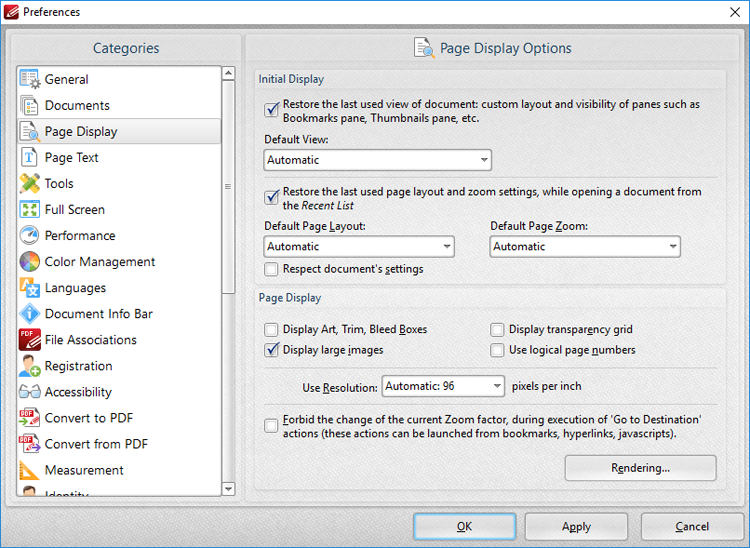 Page Display
Page Display
When the Page Display tab is selected the following dialog box is displayed:

Figure 1. Preferences Dialog Box, Page Display Tab Selected
•The Initial Display settings determine the layout of documents when they are opened:
•Select the upper check box to restore the most recent display settings. Please note that the Crop Pages settings can be used to determine page boxes.
•Use the Default View menu to select the default viewing parameters for documents.
•Select the middle check box to retain the most recently used page layout and zoom settings when recent document are opened.
•Use the Default Page Layout and Default Page Zoom dropdown menus to determine the default layout and zoom settings.
•Select the lower check box to override the settings determined in this section with the existing settings of documents.
•The Page Display settings determine what is displayed on the active page:
•Select the required check boxes. Please note that the Crop Pages feature can be used to define the Art, Trim and Bleed Boxes.
•Select an option from the Use Resolution menu to determine the viewing resolution.
•Select the indicated check box to disable zoom settings when 'Go to Destination' actions are launched.
•Click the Rendering button to determine the rendering settings. The following dialog box will open:

Figure 2. Rendering Dialog Box
•The Smoothing options are used to smooth PDF content and create a softer appearance:
•Select the desired format for smoothing text.
•Select the Smooth Line Art and Smooth Images boxes as desired.
•Please note that some fine detail may be lost as a result of using these options.
•The Advanced options determine advanced display settings for color modes and objects:
•Select the Enhance thin lines box to repair instances of blurring that may occur when using metric measurements such as point (pt).
•Use the Synchronous page rendering menu to define the page rendering method:
•Select No to disable synchronous page rendering. If this option is selected then rendering results are displayed when they are complete. Page scrolling is always smooth when this option is selected, but some pages may be blank initially. This option is best for heavy documents that contain a lot of content, as it ensures that PDF-XChange Editor remains fully responsive at all times.
•Select Yes to enable synchronous page rendering. If this option is selected then the page view in PDF-XChange Editor will wait until the content of all visible pages is rendered before displaying it on the screen. Pages will not be blank initially, but page scrolling will not always be smooth – especially on pages that contain a significant amount of content. This option is best for light documents – for example documentation that contains predominantly text and a small amount of images.
•Select Auto to combine the benefits of synchronous and asynchronous rendering. If the rendering time is small – for example in light documents – then PDF-XChange Editor operates with synchronous rendering enabled. However, if the rendering time exceeds a given threshold, then it will switch to asynchronous rendering. This means that no pages will be displayed as blank initially for light documents, and that page scrolling is always smooth for heavy documents.
•Use the Default transparency blending color space menu to select the default color space for transparency blending:
•Auto uses RGB color when there is no transparency between intersecting objects and CMYK in cases of transparency.
•Working RGB uses only RBG color space.
•Working CMYK uses only CMYK color space and converts it to RGB when displayed on-screen.
•Working Grayscale uses only grayscale when rendering.
•Use the Text Hinting menu to enable/disable text hinting, or set this feature to Auto as desired. Text hinting adjusts the display of outline fonts to make them line up with a rasterized grid.
•Use the Stroke Adjust menu to enable/disable the stroke adjust feature. Stroke adjust specifies that the line widths and coordinates of strokes are adjusted automatically to produce strokes of uniform thickness. This is performed in order to compensate for the effects of rasterization and fit lines (and other figures) more precisely to the pixel grid of monitors and other displays. The width will be as near as possible to the requested line width, and no more than half a pixel in difference. Please note that disabling Smooth Line Art when stroke adjust is enabled will have a negative effect on image quality.
•On forces the use of stroke adjust in all cases.
•Off disables the use of stroke adjust.
•Auto determines the use of stroke adjust according to the content of the file. Note that stroke adjust is not specified in most cases, and the default value is On.
Click OK to save changes.